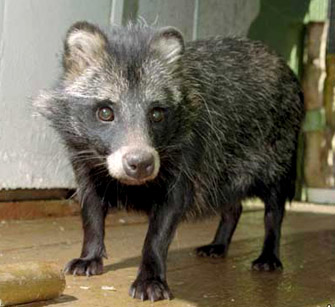
Raccoon dog(Nyctereutes procyonoides)
Phylum —chordata
Class — mammalia
Order — carnivora
Family — canidae
Genus – nyctereutes
Appearance
Reflecting their omnivorous diets, Raccoon dogs have small and weak canines and carnassials, flat molars, and relatively long intestines. They have long torsos and short legs. Total lengths can range from 45 to 71 cm (18 to 28 in). The tail, at 12 to 18 cm (4.7 to 7.1 in) long, is short, amounting to less than a third of the animal's total length. The ears are short and protrude only slightly from the fur.
Weights fluctuate according to season: in March they weigh 3 kg (6.6 lb), while in August to early September males average 6.5–7 kg (14–15 lb), with some individuals attaining a maximal weight of 9–10 kg (20–22 lb).
The winter fur is long and thick with dense underfur and coarse guard hairs measuring 120 mm in length. It is of a dirty, earth-brown, or brownish-grey colour with black guard hairs. The tail is darker than the torso. A dark stripe is present on the back, which broadens on the shoulders, forming a cross shape. The abdomen is yellowish-brown, while the chest is dark brown or blackish. The muzzle is covered in short hair, which increases in length and quantity behind the eyes. The cheeks are coated with long, whiskery hairs. The summer fur is brighter and reddish straw-coloured.
Habitat
Raccoon dogs are native to eastern Asia ranging from the eastern corner of Russia to Japan and northern India. They were introduced in Europe and now these animals are abundant throughout Estonia, Finland, Latvia, and Lithuania, Bulgaria, Serbia, France, Romania, Slovakia, Switzerland, Austria, Belarus, Poland, Bosnia and Herzegovina, Moldova, North Macedonia, Romania, Ukraine, Germany, Norway, European parts of Russia, Denmark, and Sweden.
Behavior
Raccoon dogs are social animals. They live and hunt in pairs or small family groups. However, in most sightings by humans they are seen alone. Raccoon dogs are active both during the night and day. When foraging they rely on their keen sense of smell because they have very poor vision. To hunt their prey these animals may climb trees, swim and even dive.
Raccon dogs hibernate in pairs. Hibernation starts in early winter. In areas such as Primorsky Krai (Russia) and their introduced range, Raccoon dogs hibernate only during severe snowstorms. In December, their physical activity decreases once snow depth reaches 15-20 cm, and limit the range from their burrows to no more than 150-200 m. Their daily activities increase during February when the females become receptive and when food is more available.
Raccoon dogs use vocalizations to communicate with each other. They do not bark, uttering instead a growl, followed by a long-drawn, melancholy whine. Males fighting for females may yelp and growl. Japanese Raccoon dogs produce sounds higher in pitch than those of domestic dogs and sound similar to cats.
Diet
Raccoon dogs are omnivores that feed on insects, rodents, amphibians, birds, fish, reptiles, mollusks, carrion, and insectivores, as well as fruits, nuts, and berries.
Reproduction
Raccoon dogs are monogamous and mate for life. Captive males, however, have been known to mate with four or five females. Males will fight briefly, but not fatally, for mates. Their breeding season begins from early February to late April, depending on location.
The gestation period lasts 61-70 days, with pups being born in April-May. Litter sizes typically consist of 6-8 pups, though 15-16 pups can be born in exceptional cases. Males take an active role in raising the pups. At birth, pups weigh 60-110 g, and are blind and covered in short, dense, soft wool lacking guard hairs. Their eyes open after 9-10 days, with the teeth erupting after 14-16 days. Lactation lasts for 45-60 days, though pups begin eating food brought to them as early as the age of 3 weeks to 1 month. They reach their full size at the age of 4.5 months and leave their parents in late August-September. By October, the pups, which by then resemble adults, unite in pairs. Reproductive maturity is reached at the age of 8-10 months.
Their longevity is largely unknown; animals 6–7 years of age have been encountered in the wild, while captive specimens have been known to live for 11 years.
In captivity
Domestication of these animals began in the early 90s in Europe. With their habits and intelligence Raccoon dogs are not very different from ordinary dogs, so they are kept well as pets and become their owner`s good guards. Raccoon dogs are significantly less popular than minks and ferrets, but their number as pets is growing steadily every year.
For domesticated Raccoon dogs the diet should consist of either natural ingredients (meat, fish, poultry, offal, seafood, various types of cereals with mandatory addition of vitamins and trace elements), or any industrial feed of the super-premium class for medium dogs.
 Russian
Russian
 English
English


















